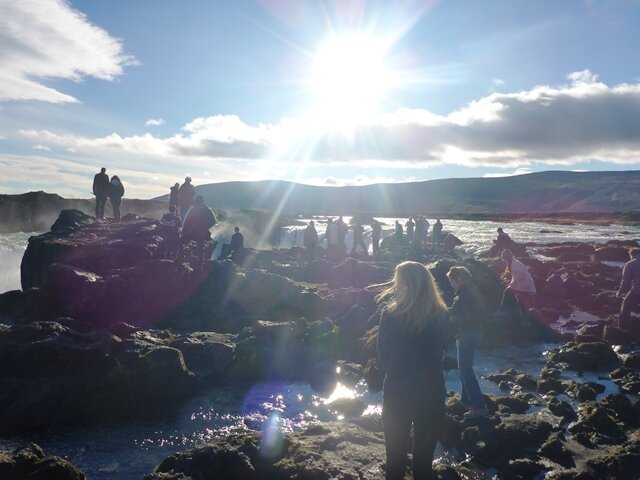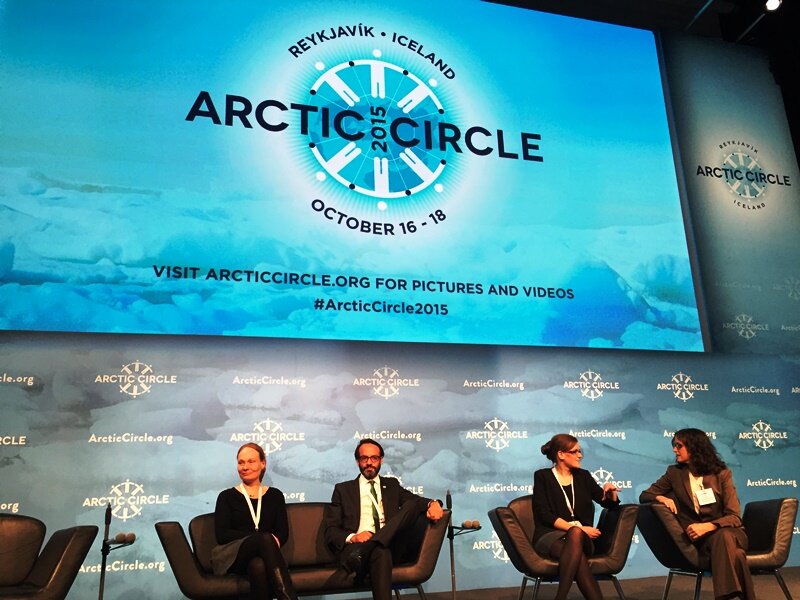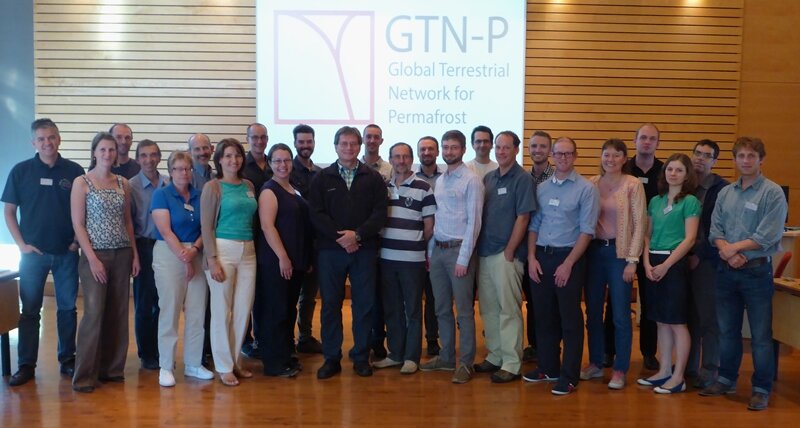BLOG: Yukon Coast 2015 -“Walking the tundra on Qikiqtaruk”
Qikiqtaruk, “people of the Island,” is the name of Herschel Island in Inuvialuit. After we settled down on July 21st - some in tents and others in fancy bunk-beds - we could relax and be busy with science! The past weeks on Qikiqtaruk, we installed all the scientific instruments that we planned, and we got most of our sampling done. Part of our research consists on understanding terrestrial processes related to permafrost thaw. This involves spending a lot of time walking on the tundra!
 First day on Qikiqtaruk's tundra (Photo: Justine Ramage)
First day on Qikiqtaruk's tundra (Photo: Justine Ramage) Anna with the DGPS, getting accurate position of Slump-D's headwall (Photo: Saskia Ruttor)
Anna with the DGPS, getting accurate position of Slump-D's headwall (Photo: Saskia Ruttor)
Anna started surveying some of the retrogressive thaw slumps with a DGPS in order to assess their evolution over several years. The DGPS measures accurately the position and elevation of a specific point. To do that, Anna walks along the slump headwall and takes measurements at regular intervals. It sometimes requires some acrobatic moves while walking on a piece of hanging tundra!
Isabell is in charge of installing the flume on Ice Creek. It is the closest valley to the camp. With this instrument we monitor the water discharge in the creek. The only issue for sampling water was that Ice Creek was totally dry! We had to wait until the first precipitation to see some water running down the valley. From this day, we turned on the automatic water sampler and Isabell and Saskia analyzed the samples in the laboratory installed in the weather haven.
 Installing the flume on Ice Creek (Photo: Hugues Lantuit).
Installing the flume on Ice Creek (Photo: Hugues Lantuit). The water started flowing in Ice Creek (Photo: Justine Ramage).
The water started flowing in Ice Creek (Photo: Justine Ramage).
Close to the flume Hugues, Jan, Saskia and Isabell installed a weather station. The recorded data will give us an idea of the local weather and will be related to the data collected from the flume. Of course, the installation was followed by a dance around the mast!Samuel set up his soil moisture and temperature stations and we had an intensive soil moisture monitoring - and rainy - day, during which all of us took soil samples along different transects and at different shallow depths. He will relate this information to the data collected by the radar TerraSAR-X, which passed over Herschel on the same day. The challenge from now on is to keep the curious bears and muskox away from the stations!
 Setting up the weather station (Photo: Justine Ramage).
Setting up the weather station (Photo: Justine Ramage). PProtected from the rain, Samuel prepares his soil moisture and temperature monitoring stations (Photo: Hugues Lantuit).
PProtected from the rain, Samuel prepares his soil moisture and temperature monitoring stations (Photo: Hugues Lantuit).
Helped by Samuel and Gustaf, I collected soil samples in the active layer and permafrost in pits located along transects crossing Fox Creek. It is a typical type of valley for Herschel and is located not far away from the camp. Another day, helped by the whole team, I organized an intensive soil pit digging activity under the rain that allowed me to get the whole Ice Creek sampled in a day!
 Everyone dancing, waiting before the start the soil sampling day!
Everyone dancing, waiting before the start the soil sampling day! Yet another soil pit (Photo: Jan Kahl).
Yet another soil pit (Photo: Jan Kahl).
Gustaf and Matthias were busy everyday with digging and sampling soil pits. Their goal is to understand the processes of cryoturbation. They dug 1 m-long trenches in the active layer and then hammered a pipe into the permafrost. After 10-days of intensive sampling, Matthias still thinks that it “feels good to sit in a soil pit everyday.”
Tarmo and Maria were lying in the tundra most of the time to count and inventory the diverse plant species around the Island. The season is a bit early this year and unfortunately most of the flowers are already gone, which make their work a bit harder.
 Matthias and Gustaf describing a permafrost core (Photo: Justine Ramage)
Matthias and Gustaf describing a permafrost core (Photo: Justine Ramage) Tarmo and Maria in the field (Photo: Saskia Ruttor)
Tarmo and Maria in the field (Photo: Saskia Ruttor)
Team Shrub - composed of Isla, Haydn, Jakob, Santeri and Joe - was busy with sampling and inventorying shrubs everyday. You can follow their field blog here: Team Shrub's Blog.
Everything is good and everyone busy on Qikiqtaruk. The tundra keeps surprising us with beautiful colors and shapes and it is a pleasure to be working here!
The next post will introduce you to the offshore research activities around the island!











